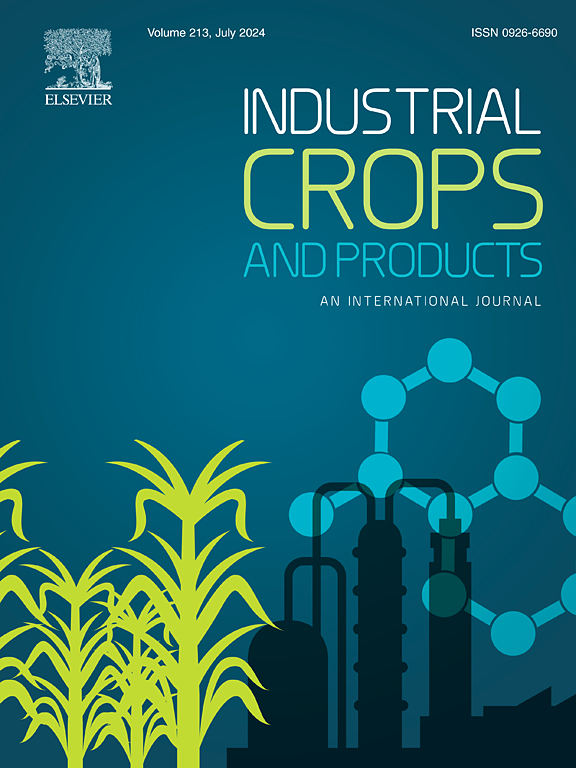可持续超轻和高强度的木基复合泡沫具有疏水,阻燃和隔热性能
IF 5.6
1区 农林科学
Q1 AGRICULTURAL ENGINEERING
引用次数: 0
摘要
本研究介绍了一种创新的方法,通过纤维素纳米纤维/聚苯并嗪-聚乙烯醇(CNFs/PBZ-PVA)复合泡沫的分子工程,用环保的质子化聚(乙亚胺)-植酸(PEI (H +)-PA)配体改性,开发可持续的高性能建筑保温材料。可再生生物基组件的使用和环保改性工艺强调了材料与循环经济原则的一致性。优化后的配方具有2:1 CNFs/PEI (H +)-PA的比例,具有优异的多功能性能,包括均匀的微孔结构(15-35 μm)、显著的抗压强度(80 %应变时2.77 MPa)和优异的保温性能(0.0504 W/(m·K))。此外,集成的P-N协同系统大大提高了阻燃性(LOI=37.2 %,UL-94 V-0评级),实现了热量释放和烟雾产生减少41.67-81.43 %。随后的硅烷改性进一步提高了疏水性(接触角114.5°)和防火安全性(LOI=39.1 %,PHRR降低82.74 %)。制造的木基隔热板具有出色的耐热性(暴露在120°C下180 s后表面温度为52.8°C),超过传统商业产品的性能。这项研究提供了一种绿色材料解决方案,有效地将热管理、机械耐久性和消防安全集成到可持续建筑应用中。本文章由计算机程序翻译,如有差异,请以英文原文为准。

Sustainable super-light and high-strength wood-based composite foam with hydrophobic, flame-retardant and thermal-insulating properties
This study introduces an innovative methodology for the development of sustainable, high-performance building insulation materials via molecular engineering of Cellulose nanofibers/Polybenzoxazine-Polyvinyl alcohol (CNFs/PBZ-PVA) composite foams modified with environmentally friendly protonated Poly(ethyleneimine)-Phytic acid (PEI (H⁺)-PA) ligand. The use of renewable bio-based components and eco-friendly modification processes underscores the material's alignment with circular economy principles. The optimized formulation, characterized by a 2: 1 CNFs/PEI (H⁺)-PA ratio, exhibits exceptional multifunctional properties, including a uniform microporous structure (15–35 μm), remarkable compressive strength (2.77 MPa at 80 % strain), and superior thermal insulation performance (0.0504 W/(m·K)). In addition, the integrated P-N synergistic system substantially enhances flame-retardancy (LOI=37.2 %, UL-94 V-0 rating), achieving reductions in heat release and smoke production by 41.67–81.43 %. Subsequent silane modification further elevates hydrophobicity (contact angle of 114.5°) and fire safety (LOI=39.1 %, 82.74 % reduction in PHRR). The fabricated wood-based insulation panel demonstrates outstanding thermal resistance (surface temperature of 52.8 °C after exposure to 120 °C for 180 s), surpassing the performance of conventional commercial products. This research offers a green materials solution that effectively integrates thermal management, mechanical durability, and fire safety for sustainable building applications.
求助全文
通过发布文献求助,成功后即可免费获取论文全文。
去求助
来源期刊

Industrial Crops and Products
农林科学-农业工程
CiteScore
9.50
自引率
8.50%
发文量
1518
审稿时长
43 days
期刊介绍:
Industrial Crops and Products is an International Journal publishing academic and industrial research on industrial (defined as non-food/non-feed) crops and products. Papers concern both crop-oriented and bio-based materials from crops-oriented research, and should be of interest to an international audience, hypothesis driven, and where comparisons are made statistics performed.
 求助内容:
求助内容: 应助结果提醒方式:
应助结果提醒方式:


